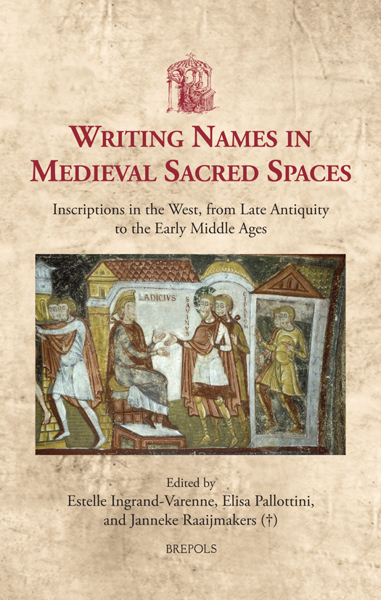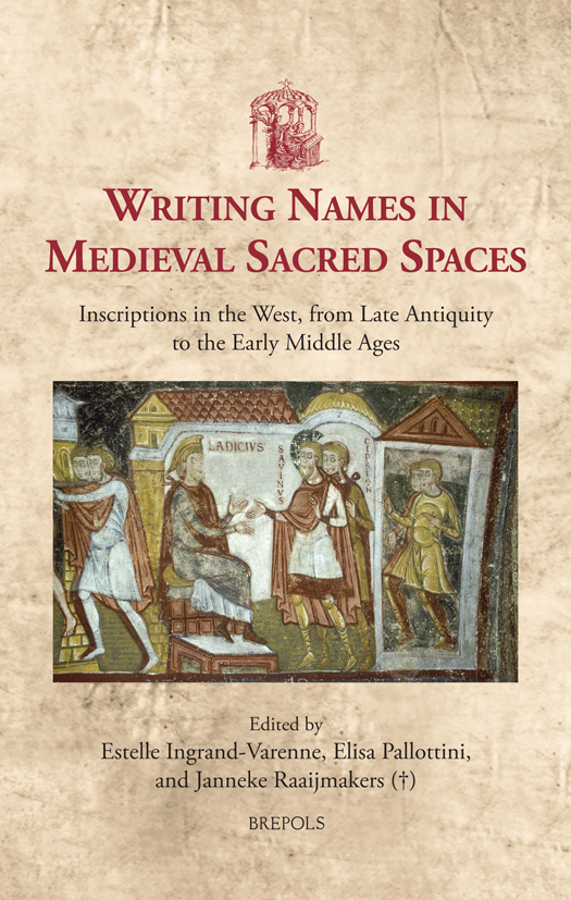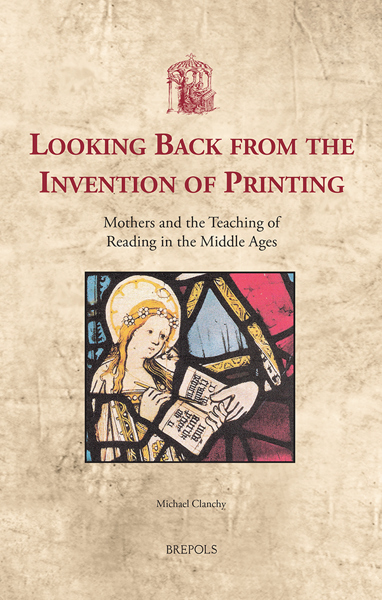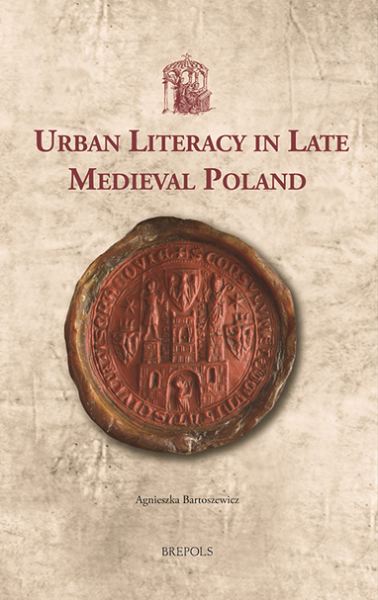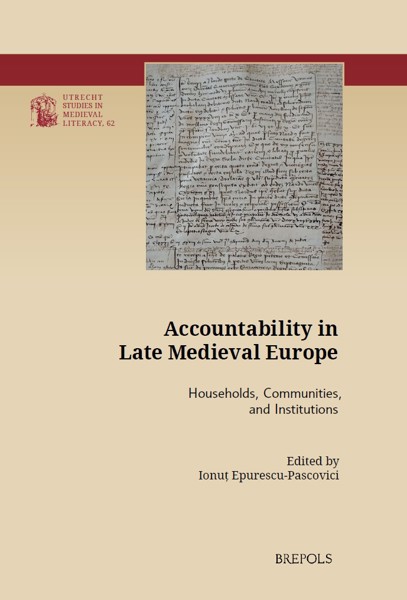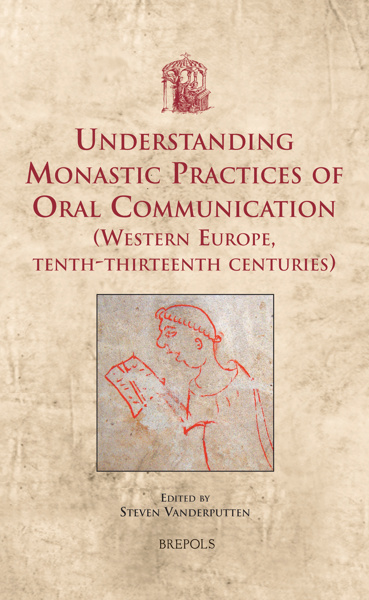
Writing Names in Medieval Sacred Spaces
Inscriptions in the West, from Late Antiquity to the Early Middle Ages
Estelle Ingrand-Varenne, Elisa Pallotini, Janneke Raaijmakers † (eds)
- Pages: xx + 386 p.
- Size:156 x 234 mm
- Illustrations:94 b/w, 26 col., 4 tables b/w., 3 maps color
- Language(s):English, French
- Publication Year:2023
- € 110,00 EXCL. VAT RETAIL PRICE
- ISBN: 978-2-503-60236-3
- Hardback
- Available
- € 110,00 EXCL. VAT RETAIL PRICE
- ISBN: 978-2-503-60237-0
- E-book
- Available
- Contains contributions in Open Access
This volume proposes a framework for reflection on practices of writing personal names in medieval sacred spaces, by focusing mainly (but not solely) on inscriptions from the Latin West, from the Late Antiquity to the Early Middle Ages.
“Sein grundsätzliches Anliegen war es, den besonderen Quellenwert von Inschriften für viele historisch arbeitende Disziplinen eigens herauszustellen und auf die verschiedenen nationalen Editionsprojekte aufmerksam zu machen, durch die Inschriften für die Forschung inzwischen gut zugänglich geworden sind. An der thematischen wie methodischen Bandbreite der Beiträge ist zu sehen, dass dieses Vorhaben gelungen ist. Der Sammelband zeigt eindrücklich, dass Bedeutungen und Funktionen von Namensinschriften weit über die bloße Identifizierung von Personen oder Dingen hinausgehen.” (Sonja Hermann, Francia-Recensio, 2, 2024)
"Il volume, agile e ben organizzato, conferma quanto lo studio delle denominazioni sia imbricato con le ricerche di paleografia, antropologia, epigrafia, linguistica, storia e storia dell’arte." (Gerardo Larghi, in Medioevo Europeo, 8(2), 2024, p. 179)
Elisa Pallottini (Utrecht University – University “G. D’Annunzio” of Chieti-Pescara) is a Latin Paleographist working in the field of Medieval Written Culture and Epigraphy.
Estelle Ingrand-Varenne (CNRS – CRFJ/CESCM) is specialized in medieval epigraphy, in France and in the Latin East. She is the principal investigator of the ERC GRAPH-EAST.
Janneke Raaijmakers (1973-2021) was an internationally valued authority on the topic of relics. The author of The Making of the Monastic Community of Fulda, c. 744-c. 900 (Cambridge, 2012), she also ran project ‘Mind over Matter: Debates about the Sanctity of Religious Objects, ca. 400-1200’ (Utrecht 2012-2018), was co-organiser of an exhibition on relics at Museum Het Catharijneconvent (see Relieken, Utrecht and Zwolle, 2018), and co-directed an international French-Dutch project, ‘MEDNAME: Inscribing Names in Medieval Sacred Spaces’.
This volume proposes a framework for reflection on practices of writing personal names in medieval sacred spaces, uniting historians, art historians, and specialists in written culture (both epigraphers and palaeographers). It traces the forms and functions of names that can be found within the space of early medieval churches and cemeteries, focusing mainly, but not solely, on inscriptions. By examining names written in various kinds of media, from liturgical books to graffiti and more formal inscriptions, the contributors investigate the intentions and effects of the act of writing one’s own name or having one’s name written down. Their interest resides less in the name itself than the interactions it had with its spatial, iconographic, linguistic, ritual, and cultural context, and what this indicates about medieval graphical practices. What is a name from a graphic point of view? What are the specificities of the epigraphic manifestations of names? By whom were names written, and for whom were they intended (if they were even meant to be accessed)? Addressing these and other questions, this volume shows the importance of inscriptions as historical sources and the contribution they give to the study of medieval societies at the intersection of history, anthropology, archaeology, linguistics, and semiology.
Introduction — VINCENT DEBIAIS
Le nom et l’être: De la théorie aux mises en forme épigraphiques — ESTELLE INGRAND-VARENNE
Graver son nom dans la pierre: Aspects techniques et culturels — THIERRY GREGOR
Topographie du nom du saint dans l’église: L’exemple des inscriptions brèves de dédicace — ANNICK GAGNÉ
Le nom, marque dans l’image et marqueur de l’objet — VINCENT DEBIAIS
Le nom à l’oeuvre: Les signatures épigraphiques d’artistes et de commanditaires entre quête de gloire et perspectives eschatologiques — EMILIE MINEO
Hic fuit: Scratching Names on Sacred Walls — CARLO TEDESCHI
Saints’ Names and Relics: The Evidence of Church Inscriptions — ELISA PALLOTTINI
Ces morts dont on inscrit le nom dans la pierre ... — CÉCILE TREFFORT
Et breve in exigo marmore nomen ero: Un seul nom pour épitaphe (Gaule, Aquitaine, VIe-VIIIe s.) — MORGANE UBERTI
The Memory of a Person’s Name — JANNEKE RAAIJMAKERS
The Social Meaning of Names — JANNEKE RAAIJMAKERS
Naming as a Liturgical Act — ELS ROSE
Beyond the Pale? Those Who Were Not Worthy to Be Named — MARCO MOSTERT
Conclusions — ESTELLE INGRAND-VARENNE, ELISA PALLOTTINI, and JANNEKE RAAIJMAKERS
Bibliography
Indices
